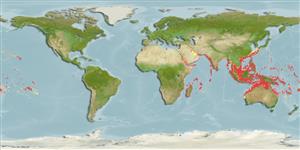Teleostei (teleosts) >
Eupercaria/misc (Various families in series Eupercaria) >
Lethrinidae (Emperors or scavengers) > Monotaxinae
Etymology: Gymnocranius: Greek, gymnos = naked + Greek, kranion = skull (Ref. 45335).
More on author: Valenciennes.
Environment: milieu / climate zone / depth range / distribution range
Ecology
Marine; reef-associated; non-migratory; depth range 20 - 170 m (Ref. 12260). Tropical; 35°N - 28°S, 32°E - 134°W
Indo-Pacific: East Africa to southeastern Oceania and from Australia northward to Japan. This species has been referred to as Gymnocranius robinsoni in recent literature.
Size / Weight / Age
Maturity: Lm ? range ? - ? cm
Max length : 80.0 cm TL male/unsexed; (Ref. 2295); common length : 64.0 cm SL male/unsexed; (Ref. 37816); max. published weight: 5.5 kg (Ref. 40637)
Inhabits offshore reefs (Ref. 9710), trawling grounds of the continental shelves and offshore rocky bottoms (Ref. 30573). Juveniles inshore on muddy substrates (Ref. 48635). Solitary or in small groups (Ref. 90102). Feeds mostly on bottom invertebrates and small fishes (Ref. 30573). Potential commercial fish if sufficient stocks can be located (Ref. 9775). Marketed fresh (Ref. 9775); sometimes with a strong and unpleasant flavor (Ref. 11888).
Life cycle and mating behavior
Maturity | Reproduction | Spawning | Eggs | Fecundity | Larvae
Carpenter, K.E. and G.R. Allen, 1989. FAO Species Catalogue. Vol. 9. Emperor fishes and large-eye breams of the world (family Lethrinidae). An annotated and illustrated catalogue of lethrinid species known to date. FAO Fish. Synop. 125(9):118 p. Rome: FAO. (Ref. 2295)
IUCN Red List Status (Ref. 130435: Version 2024-2)
Threat to humans
Harmless
Human uses
Fisheries: minor commercial; gamefish: yes
Tools
Special reports
Download XML
Internet sources
Estimates based on models
Preferred temperature (Ref.
123201): 21.6 - 28.3, mean 26.8 °C (based on 971 cells).
Phylogenetic diversity index (Ref.
82804): PD
50 = 0.5010 [Uniqueness, from 0.5 = low to 2.0 = high].
Bayesian length-weight: a=0.01905 (0.01114 - 0.03260), b=2.89 (2.74 - 3.04), in cm total length, based on LWR estimates for this species & (Sub)family-body (Ref.
93245).
Trophic level (Ref.
69278): 3.8 ±0.0 se; based on diet studies.
Generation time: 4.8 ( na - na) years. Estimated as median ln(3)/K based on 1
growth studies.
Resilience (Ref.
120179): Medium, minimum population doubling time 1.4 - 4.4 years (K=0.23).
Fishing Vulnerability (Ref.
59153): Moderate vulnerability (42 of 100).
Nutrients (Ref.
124155): Calcium = 24.1 [12.4, 44.5] mg/100g; Iron = 0.444 [0.237, 0.745] mg/100g; Protein = 19.7 [17.7, 21.7] %; Omega3 = 0.133 [0.079, 0.191] g/100g; Selenium = 49.7 [31.1, 84.0] μg/100g; VitaminA = 47.9 [15.7, 134.6] μg/100g; Zinc = 0.876 [0.633, 1.196] mg/100g (wet weight);
